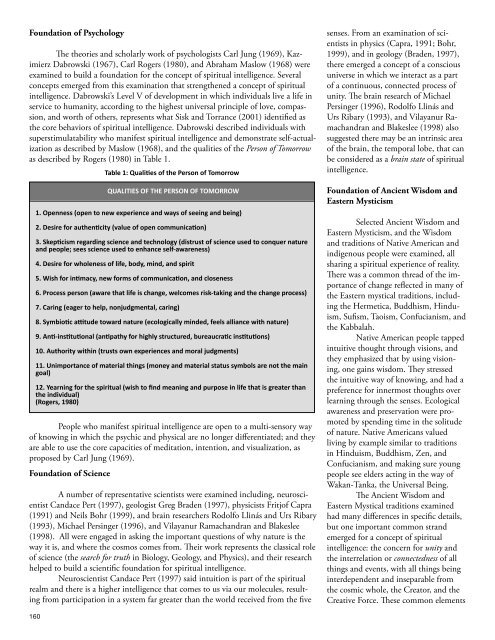Torrance Journal for Applied Creativity
TorranceJournal_V1
TorranceJournal_V1
Create successful ePaper yourself
Turn your PDF publications into a flip-book with our unique Google optimized e-Paper software.
Foundation of Psychology<br />
The theories and scholarly work of psychologists Carl Jung (1969), Kazimierz<br />
Dabrowski (1967), Carl Rogers (1980), and Abraham Maslow (1968) were<br />
examined to build a foundation <strong>for</strong> the concept of spiritual intelligence. Several<br />
concepts emerged from this examination that strengthened a concept of spiritual<br />
intelligence. Dabrowski’s Level V of development in which individuals live a life in<br />
service to humanity, according to the highest universal principle of love, compassion,<br />
and worth of others, represents what Sisk and <strong>Torrance</strong> (2001) identified as<br />
the core behaviors of spiritual intelligence. Dabrowski described individuals with<br />
superstimulatability who manifest spiritual intelligence and demonstrate self-actualization<br />
as described by Maslow (1968), and the qualities of the Person of Tomorrow<br />
as described by Rogers (1980) in Table 1.<br />
Table 1: Qualities of the Person of Tomorrow<br />
QUALITIES OF THE PERSON OF TOMORROW<br />
1. Openness (open to new experience and ways of seeing and being)<br />
2. Desire <strong>for</strong> authenticity (value of open communication)<br />
3. Skepticism regarding science and technology (distrust of science used to conquer nature<br />
and people; sees science used to enhance self-awareness)<br />
4. Desire <strong>for</strong> wholeness of life, body, mind, and spirit<br />
5. Wish <strong>for</strong> intimacy, new <strong>for</strong>ms of communication, and closeness<br />
6. Process person (aware that life is change, welcomes risk-taking and the change process)<br />
7. Caring (eager to help, nonjudgmental, caring)<br />
8. Symbiotic attitude toward nature (ecologically minded, feels alliance with nature)<br />
9. Anti-institutional (antipathy <strong>for</strong> highly structured, bureaucratic institutions)<br />
10. Authority within (trusts own experiences and moral judgments)<br />
11. Unimportance of material things (money and material status symbols are not the main<br />
goal)<br />
12. Yearning <strong>for</strong> the spiritual (wish to find meaning and purpose in life that is greater than<br />
the individual)<br />
(Rogers, 1980)<br />
People who manifest spiritual intelligence are open to a multi-sensory way<br />
of knowing in which the psychic and physical are no longer differentiated; and they<br />
are able to use the core capacities of meditation, intention, and visualization, as<br />
proposed by Carl Jung (1969).<br />
Foundation of Science<br />
A number of representative scientists were examined including, neuroscientist<br />
Candace Pert (1997), geologist Greg Braden (1997), physicists Fritjof Capra<br />
(1991) and Neils Bohr (1999), and brain researchers Rodolfo Llinás and Urs Ribary<br />
(1993), Michael Persinger (1996), and Vilayanur Ramachandran and Blakeslee<br />
(1998). All were engaged in asking the important questions of why nature is the<br />
way it is, and where the cosmos comes from. Their work represents the classical role<br />
of science (the search <strong>for</strong> truth in Biology, Geology, and Physics), and their research<br />
helped to build a scientific foundation <strong>for</strong> spiritual intelligence.<br />
Neuroscientist Candace Pert (1997) said intuition is part of the spiritual<br />
realm and there is a higher intelligence that comes to us via our molecules, resulting<br />
from participation in a system far greater than the world received from the five<br />
senses. From an examination of scientists<br />
in physics (Capra, 1991; Bohr,<br />
1999), and in geology (Braden, 1997),<br />
there emerged a concept of a conscious<br />
universe in which we interact as a part<br />
of a continuous, connected process of<br />
unity. The brain research of Michael<br />
Persinger (1996), Rodolfo Llinás and<br />
Urs Ribary (1993), and Vilayanur Ramachandran<br />
and Blakeslee (1998) also<br />
suggested there may be an intrinsic area<br />
of the brain, the temporal lobe, that can<br />
be considered as a brain state of spiritual<br />
intelligence.<br />
Foundation of Ancient Wisdom and<br />
Eastern Mysticism<br />
Selected Ancient Wisdom and<br />
Eastern Mysticism, and the Wisdom<br />
and traditions of Native American and<br />
indigenous people were examined, all<br />
sharing a spiritual experience of reality.<br />
There was a common thread of the importance<br />
of change reflected in many of<br />
the Eastern mystical traditions, including<br />
the Hermetica, Buddhism, Hinduism,<br />
Sufism, Taoism, Confucianism, and<br />
the Kabbalah.<br />
Native American people tapped<br />
intuitive thought through visions, and<br />
they emphasized that by using visioning,<br />
one gains wisdom. They stressed<br />
the intuitive way of knowing, and had a<br />
preference <strong>for</strong> innermost thoughts over<br />
learning through the senses. Ecological<br />
awareness and preservation were promoted<br />
by spending time in the solitude<br />
of nature. Native Americans valued<br />
living by example similar to traditions<br />
in Hinduism, Buddhism, Zen, and<br />
Confucianism, and making sure young<br />
people see elders acting in the way of<br />
Wakan-Tanka, the Universal Being.<br />
The Ancient Wisdom and<br />
Eastern Mystical traditions examined<br />
had many differences in specific details,<br />
but one important common strand<br />
emerged <strong>for</strong> a concept of spiritual<br />
intelligence: the concern <strong>for</strong> unity and<br />
the interrelation or connectedness of all<br />
things and events, with all things being<br />
interdependent and inseparable from<br />
the cosmic whole, the Creator, and the<br />
Creative Force. These common elements<br />
160


